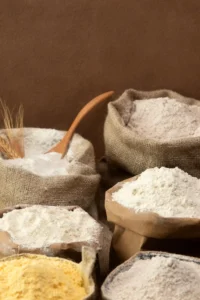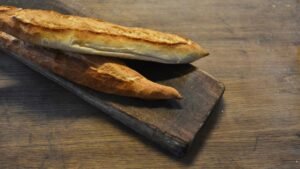You may be familiar with unleavened bread, especially for religious celebrations such as Eucharist and Passover. But do you really know what unleavened bread is? What are its historical roots and significance? How does it differ from leavened bread? And what are the most popular types of unleavened bread? Read on to find answers to all your questions about this type of bread.

What Is Unleavened Bread?
Unleavened bread refers to any type of bread made using any type of flour, water, and salt without any leavening agents such as yeast, starter, baking soda, or baking powder. As a result, unleavened bread dough does not rise, resulting in a flat, often dense texture.
The History and Origins of Unleavened Bread
You may not be aware of it, but unleavened bread is the oldest type of bread known to mankind, made from basic bread ingredients such as flour, water and salt. This was before the advent of fermentation in southern Mesopotamia around 6000 BCE, which later spread to ancient Egypt around 3000 BCE. Phys.org sources say that it was first made about 30,000 years ago in Europe. During that time, it is believed that starch from the roots of plants, such as reeds and fern
Religious Significance of Unleavened Bread
Unleavened bread holds significant symbolic meaning in both Judaism and Christianity:

For Jews
Unleavened bread has a deep significance in the Jewish tradition, as it is the bread that the Israelites prepared during the Exodus from Egypt, as mentioned in the Bible. God told them to not eat leavened bread, as a perpetual reminder of their exodus from Egypt (Deuteronomy 3:16). Other references to the consumption of unleavened bread appear in Exodus 12:8, 29:2, and Numbers 9:11. During Passover, Jews eat unleavened bread to commemorate the quick exodus of the Israelites from Egypt, where they get rid of all the leaven in their homes and eat unleavened bread for 7 days.
For Christians
Many Christian traditions believe that Jesus used unleavened bread at the Last Supper meal when he said, “This is my body broken for you” as stated in Corinthians 11.24 This belief has led to the practice of using unleavened bread in the Eucharist to represent Jesus’ sinless nature and sacrificial love.
Leavened vs Unleavened Bread
The main difference between leavened and unleavened bread lies in the absence of leavening agents in unleavened bread, whereas leavened bread contains leavening agents. Leavened bread can be classified into 3 categories: quick, yeast, and sourdough bread. These agents work to release carbon dioxide gas, which causes the bread dough to rise and puff up during fermentation and baking process, resulting in the light, airier texture that characterizes these bread types. On the other hand, unleavened bread are made without yeast, and usually formed into thin layers, resulting in a flatter and denser consistency.
Related: What is Leavened Bread?
Varieties of Unleavened Bread
Although it relies on simple ingredients, unleavened bread comes in a variety of shapes, sizes, and flavors globally, making it almost impossible for any kitchen to be without this type of bread. Here’s a list of 5 types of unleavened bread that are traditionally made without leavening agents other than the ones you may already know, such as matzo, tortillas, and lavash:
- Lefse: Traditional Norwegian flatbread, mainly composed of potatoes, cooked on a flat griddle and has a tender, thin texture. Lefse is available in various flavors, including lingonberries, cinnamon, tynnlefse, and more.
- Tunisian Mlawi: Typically prepared using semolina flour, water, salt, and olive oil, the dough is kneaded and formed into square or circular layers, which are then cooked on a traditional grill. Malawi is mainly served wrapped in harissa and Mechouia salad with toppings such as tuna or boiled eggs.
- Gözleme: A flat, unleavened white bread originating from Anatolia, typically brushed with oil or butter, stuffed with ingredients like mashed potatoes, cheese, parsley, or a sweet feeling like chocolate and nuts, and then baked on a griddle.
- Damper: Known as Bushman’s bread, damper is prepared from a dough that usually consists of wheat flour, salt, and water, and it is traditionally baked by placing it directly on the embers of a campfire.
- Saj bread: Made from a blend of white flour, whole wheat flour and water, the dough is allowed to rest for several hours before being rolled into extremely thin layers and cooked on a grill.
Even though these breads are traditionally made without yeast, modern recipes may include yeast to enhance density and achieve a softer, more open crumb. Therefore, if you prefer to eat unleavened bread, be sure to check the recipe or product to see if it contains the leavening agent before eating it.
Related: 11 Types of Unleavened Bread
Recipes for Unleavened Bread
If you’re already a fan of unleavened bread and want to explore various recipes, you’ll be pleased to know there are many of them available. From traditional recipes that will feel familiar if you’re a seasoned baker to simple options that are perfect for when you’re short on time or for religious occasions like Passover and Communion.




